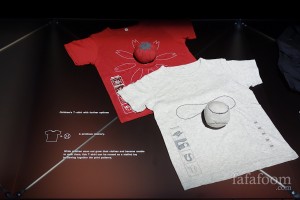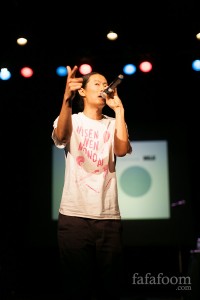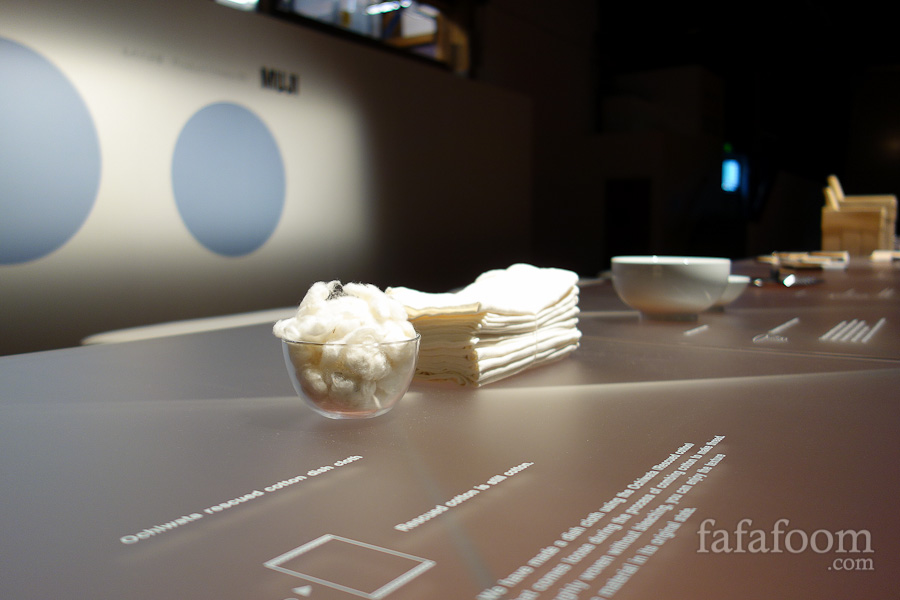Let’s say you are a designer or a design enthusiast. Have you ever thought of a product design based on its “fitness”? Better yet, have you ever thought about how to design products using only 80% of the materials that you have? (No, this is not a Project Runway challenge.) At MUJI Product Fitness 80 Exhibition at SOMArts Cultural Center, MUJI asked the visitors exactly these two questions and encouraged us to contemplate more about product design.
The Japanese retail company MUJI is known for its complex design process that yields simplicity. Its “monozukuri” (read: craftsmanship) of design and manufacturing continually focuses on self-restrain in delivering high quality products with sensible pricing. Questions like “Is this necessary?” or “Is this going too far?” are part of the foundation MUJI is made of, and why it is popular for selling products with high quality design in their pure state without unnecessary bells and whistles. You can tell I’m a MUJI lover; so happy it’s coming to San Francisco to open its first West Coast store in late November!
From August 24 – 30, 2012, MUJI’s “Product Fitness 80” exhibition at SOMArts invited us to reconsider the way we consume materials and energy, most notably in products we use daily. The March 2011 earthquake and tsunami disaster that stunned Japan and the rest of the world was a huge, forceful, and sudden motivation that brought urgency for us to reconsider our lifestyles.
 MUJI offered answers for that question with a display of commonly used products, such as towels, pot lids, stationery, and umbrella, among others. How about having a lid that fit 5 different pot sizes? Having toilet tissue rolls that have 20% less width? Making needle pin cushion out of T-shirts your child has outgrown (pictured right)? Or a simple sofa that is comfortable enough to sleep on?
MUJI offered answers for that question with a display of commonly used products, such as towels, pot lids, stationery, and umbrella, among others. How about having a lid that fit 5 different pot sizes? Having toilet tissue rolls that have 20% less width? Making needle pin cushion out of T-shirts your child has outgrown (pictured right)? Or a simple sofa that is comfortable enough to sleep on?
The possibilities are endless and exciting, and the roughly 70+ young adult crowd that attended the closing night party on August 30 were clearly intrigued and excited about the ideas MUJI offers. Even MUJI President Hiroyoshi Azami was also in attendance for the whole evening. If anything, it effectively builds up expectation for the new store opening.
 Shing02 (a versatile Japanese rapper who arrived in the Bay Area 20 years ago and was featured on Samurai Champloo’s “Battlecry”) and DJ Icewater joined the closing night by holding a talk show and live concert. I particularly enjoyed the talk show, in which Shing02 lamented the less desirable effect of the hyper digital age we live in and how it negatively affects our personal contacts and how we interact with each other.
Shing02 (a versatile Japanese rapper who arrived in the Bay Area 20 years ago and was featured on Samurai Champloo’s “Battlecry”) and DJ Icewater joined the closing night by holding a talk show and live concert. I particularly enjoyed the talk show, in which Shing02 lamented the less desirable effect of the hyper digital age we live in and how it negatively affects our personal contacts and how we interact with each other.
Presenting two short films (“then-n-now” and “Petals of Fire”) that he wrote and directed, Shing02 led the discussion and expressed his take on the evolving way people communicate nowadays, especially for the past three years. The popular social media communication brings forth the illusion of “people are more connected than ever”, while in reality they are becoming more distant. While technology advances rapidly and people sometimes struggle to keep up, we need to learn how to exist again; how to not forget of things that make us human and keep the balance between personal and digital interactions. Later on, Shing02 and DJ Icewater teamed up to deliver a live concert.
Before I go any further in stating my opinion about the topic Shing02 raised during his talk show segment, I’d like to share the pictures that Chris and I took that night. See if you are also getting excited about MUJI’s upcoming store opening and knowing Shing02 and DJ Icewater better (if you haven’t already)!
Please click once on the image below to expand the whole album:
[shashin type=”album” id=”214″ size=”medium” crop=”n” columns=”max” caption=”y” order=”date” position=”center”]
Perhaps Shing02’s take is old school, one that is less popular in this latest-social-media-and-tech-gadgets-crazed society. Yes, the advancement in technology enables us to get the latest news and content (I enjoy seeing NYFW unfolds from the convenience of my sofa, as a lot of you do, too), but he is right in pointing out that the more content we receive, the less time we get for digesting each of them. The number of “followers” we get, while it’s good for our ego and our Klout score, it’s probably less impactful in our personal interactions in real life.
This kind of digital era and social media topics are everywhere, and naturally a great deal of us have our own opinion about it. I personally think that the technology advancements are great tools to reach out to people that I would otherwise have enormous difficulty reaching (and write about in fafafoom). Exposures from social media and word-of-mouth enable us to meet cool people like Shing02 who discusses the sometimes uncomfortable side of technology advancements. On the other hand, the question is whether we use technology advancements merely for consumption, for production, or a mixture of both. We all can immediately form opinions which type of use we are in, and even the definition of each type can be arguable :)
This discussion can be long, and it is perhaps a topic to be expanded another day. But Shing02 offered a nice, valid reminder for us not to get consumed by social media and followed the latest, greatest technology advancements blindly. Instead, using them to help you realize your cool ideas or share your passion while maintaining a healthy dose of real world in-person interactions, that would make us more grounded as humans. Don’t you agree?
Thank you for reading. Until next time,
Musank

